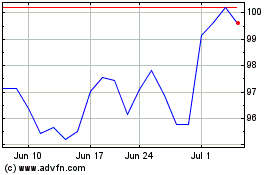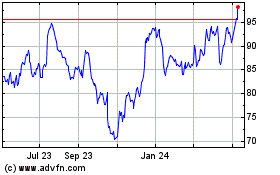By Rory Jones in Dubai and Avantika Chilkoti in London
This article is being republished as part of our daily
reproduction of WSJ.com articles that also appeared in the U.S.
print edition of The Wall Street Journal (August 6, 2019).
U.S. banks are cashing in on a public-debt boom among oil-rich
Persian Gulf nations, muscling into lending territory long
dominated by rivals.
Citigroup Inc., JPMorgan Chase & Co., Goldman Sachs Group
Inc. and Morgan Stanley are leading a corporate- and sovereign-bond
spree in the Gulf Cooperation Council, a group of six Arab nations
that includes Saudi Arabia, the United Arab Emirates, Kuwait,
Qatar, Bahrain and Oman. U.S. banks have earned four times as much
in fees from bond issuance in the GCC so far this year compared
with 2015, the year before the region embarked on a debt binge,
according to fees data from Refinitiv.
The U.S. banks' improving position in GCC debt in part reflects
a new aggressiveness in the region, but it also comes down to
petrostates seeking more cash during a period of low oil prices. In
total, the GCC countries have issued $150 billion in
foreign-currency debt since the beginning of 2016 -- the year oil
prices hit a 12-year low, according to Dealogic. That is up from
$24 billion in the prior four years, when oil prices were often
above $100 a barrel.
"There was not a lot of issuance of GCC sovereign debt 10, or
even five years ago. Now there's a lot," said Hasnain Malik, a
Dubai-based analyst at Tellimer Group. "U.S. banks have asserted
their competitive advantage in debt capital markets."
The emergence of American banks demonstrates the scramble among
financial institutions to get a foothold in the Middle East during
a tumultuous period of change. Saudi Arabia especially has
presented itself as a potential investment destination, landing its
stock market on the MSCI's emerging-market index this year,
launching a program to develop non-oil industries and planning an
initial public offering of its giant national petroleum firm, Saudi
Arabian Oil Co., or Aramco.
Bankers consider the debt sales as a way to develop a broader
relationship with a country's finance officials. Citigroup last
year returned to Saudi Arabia after a 14-year hiatus and Goldman
has been hiring investment bankers there.
Morgan Stanley and JPMorgan were the chief arrangers of Aramco's
bonds in April, a landmark $12 billion sale that received nearly 10
times that figure in orders.
Already, the debt work has spurred more lucrative business.
Goldman Sachs and Morgan Stanley won advisory mandates on the
region's recent megamerger: Aramco's $69.1 billion purchase of
Saudi Arabia's national petrochemicals firm from the country's
sovereign-wealth fund.
Though sparked by the 2014-16 oil-price crash, the region's debt
binge has continued as governments spend on economic overhauls and
seek to develop domestic capital markets. Big companies also have
started tapping more capital-market finance than straight lending.
This year, banks have earned nearly the same in fees from debt
sales as arranging loans -- a cultural shift in the region, driven
by the huge sovereign issuance.
U.S. banks are carving out a niche in territory once dominated
by European rivals. The majority of bonds sold in recent years were
in dollars, allowing American banks to espouse the virtues of their
U.S. networks, according to bankers and regional capital-markets
lawyers.
American banks emerged financially stronger from the global
financial crisis than some of their European peers, positioning
themselves to benefit from Gulf debt sales. JPMorgan employed 30
staff in the region during the financial crisis in 2008, and now
has a workforce of 225 across all roles, with about 80 people in
Saudi Arabia.
The biggest Gulf debt brokers remain two London-based banks that
have long been in the region: HSBC Holdings PLC and Standard
Chartered PLC. They have larger operations there than their
American peers and were the top fee earners for debt capital
markets this year. HSBC in January opened a new $250 million
headquarters in the U.A.E., next door to the Standard Chartered
Tower in Dubai.
Other European banks haven't fared as well. Deutsche Bank AG and
Barclays PLC, both still feeling the financial crisis's effects,
trimmed staff in recent years. Bankers from other institutions also
left the Gulf, as business looked unpromising in 2015 amid low oil
prices. The region's cultural shift to bonds rather than lending
also has meant Japanese banks, previously big loan arrangers, have
lost fees to U.S. banks.
"A lot of it comes down to just how much the European banks are
retreating from their investment banking businesses," said Anthony
Simond, an investment manager focused on emerging-market debt at
U.K.-based Aberdeen Standard Investments.
The one market U.S. banks haven't been active in arranging bonds
is Qatar. Saudi Arabia and the U.A.E. have imposed an economic
boycott on their neighbor for alleged support for extremist groups,
creating a sticky situation for financiers.
JPMorgan executives in April 2018 informally told Qatari
officials they couldn't work on the country's coming bond issuance
because it would jeopardize the U.S. bank's relationship with Saudi
Arabia, The Wall Street Journal reported, citing people familiar
with the matter.
Deutsche Bank, Barclays and Credit Suisse Group AG -- all of
which have large Qatari shareholders -- have been the core banks
involved in arranging Qatar's sovereign-debt issuance in recent
years.
While most economists and credit-rating firms don't consider
Gulf states such as Qatar, Saudi Arabia and the U.A.E.
overleveraged, some contrarian investors are taking short positions
against the region's credit, betting the countries are raising debt
too fast.
Economists estimate Oman and Bahrain are the two Gulf states
most susceptible to a payment default, although many think Saudi
Arabia would come to Bahrain's aid to avoid a financial default.
The International Monetary Fund estimates Oman and Bahrain's
debt-to-GDP levels this year will reach 60% and 100%, respectively.
Citi and JPMorgan have arranged bonds for both states.
Write to Rory Jones at rory.jones@wsj.com and Avantika Chilkoti
at Avantika.Chilkoti@wsj.com
(END) Dow Jones Newswires
August 06, 2019 02:47 ET (06:47 GMT)
Copyright (c) 2019 Dow Jones & Company, Inc.
Morgan Stanley (NYSE:MS)
Historical Stock Chart
From Mar 2024 to Apr 2024

Morgan Stanley (NYSE:MS)
Historical Stock Chart
From Apr 2023 to Apr 2024
